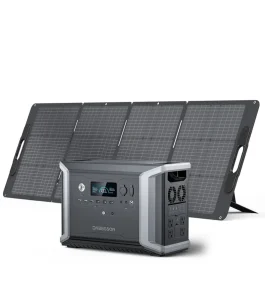How A Portable Power Station Can Take The Place Of A Generator In Many Applications Clean, quiet and portable power… Compact power stations, on the other hand unlike fuel-powered generators operates engines and therefore are quiet and do not release emissions, which is as a consequence of these utilizing lithium-ion or lithium iron phosphate (LiFePO4) batteries. The Dabbsson DBS2300 Plus model has an output of 2,300W and a capacity of 2,300Wh — sufficient to keep household essentials such as refrigerators, lighting & communication devices running for several hours during a short-term grid outage.
This gives enough backup in terms of battery capacity for short-term and medium use scenarios where it can be considered only when the PPS has substantial back-uptime. At its capacity of 2,300Wh the DBS2300 Plus can keep something like a refrigerator running for about two dozen hours or charge multiple devices through multiple cycles, which makes this one more fitting for household use. But, the primary restriction is that all of these should be recharged through AC outlets or solar panels which means you can only use them until they run out of power once those are out of power you need to wait till they get charged. unlike the generators that run as long as there is fuel left in them. High-capacity traditional generators suited for longer, high-power demands such as repeated long running of an HVAC system probably make more practical couponing applications for outputs over 5,000W; portable stations work well in a pinch or temporarily.

Portability — in terms of safety and environmental impact — also gives a nod to portable power station. Whereas generators emit carbon monoxide and must be used outside to avoid risk of poisoning, portable power station do not produce any emissions so they are safe for use indoors. With lithium iron phosphate batteries (as used in the DBS2300 Plus model), we have data to show that around 3,000 charge cycles (shade under 10 years exposure on the African continent) are wholly ago of before battery replacement is necessary making these just as eco-friendly to utilise as they are cost-efficient when compared with ongoing fuel costs using a generator plant.
Portable power station are made all the more useful because of solar compatibility. In some instances, the DBS2300 Plus for example can take up to 800 watts of solar input with full recharging taking around 3–4 hours ideal conditions. Effectively, this stops you from having to rely on the grid – which also comes in handy for extended power outages if there is enough sun to get some rechargeability – a thing that gas generators notably lack.
But in the absence of grid power — or as a backup when outages occur or you're living off-grid — reliable, sustainable power for your critical devices is key to health and well-being for homeowners. While this obviously won't compete with the continuous output of gas generators in every way, for shorter to mid-term needs it represents a viable cleaner alternative.